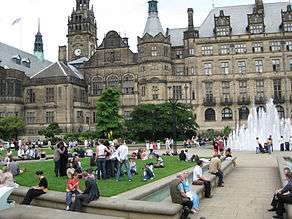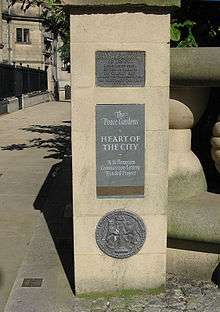Peace Gardens


The Peace Gardens are an inner city square in Sheffield, England. It was created as part of the Heart of the City project by Sheffield City Council.
The Gardens themselves front onto Sheffield's gothic town hall (not to be confused with the Sheffield City Hall, a popular concert venue), creating a spectacular view as shoppers and visitors sit in the gardens.
It has won many awards, and was one of the major sites responsible for Sheffield's first place in the Entente Florale 2005.
History
The Gardens were first laid out in 1938, following the demolition of St Paul's Church. Originally named St Paul's Gardens, they were immediately nicknamed the "Peace Gardens", marking the contemporary signing of the Munich Agreement.[1] The Gardens were originally intended to be replaced by an extension to the Town Hall, but due to World War II, this was never built.[2] In 1985, the space was formally renamed the "Peace Gardens".[3] The Sheffield gardens are a fine example of the network of similar gardens created between the two world wars and presage later gardens and community spaces in London and other urban centres.[4]
Features

Public Consultation showed strong support for a garden rather than the multi purpose open square which had been earlier advised by architectural consultants. It has fountains at the centre, and cascades around the outside. These are to represent the flowing molten steel, which made Sheffield famous, and also the water of Sheffield's rivers, the Sheaf, River Don, River Rivelin, River Loxley and Porter Brook, which were used to power the mills which drove Sheffield's industry.
The site contains several memorials for Sheffielders who served in wars, including in the Spanish Civil War and another plaque commemorating Sheffielders who gave their lives in all conflicts, including the Korean War. It also contains a memorial to Hiroshima, unveiled on Hiroshima Day, 8 August 1985, in the presence of three survivors of the atomic devastation.[5] Other memorials include the Holberry Cascades, named for local Chartist leader Samuel Holberry, the Bochum Bell, donated by Sheffield's twin city, and a set of standard measures.[2]
Gallery
-

War plaque
-

Spanish Civil War Plaque
-

Holberry Plaque
-

Heart of the City
-

Standard Measures of yard and metre
See also
References
- ↑ Ruth Harman and John Minnis, Pevsner Architectural Guides: Sheffield
- 1 2 The Peace Gardens, Sheffield City Council
- ↑ Chen Chao, Sights in Sheffield: The Peace Gardens
- ↑ Gough, P.J. (2007) Planting peace: the Greater London Council and the community gardens of central London, International Journal of Heritage Studies, Vol.13, No 1, pp.22-41
- ↑ 13. "The New Peace Gardens" in More Sheffield Curiosities by Duncan & Trevor Smith.
Coordinates: 53°22′48″N 1°28′11″W / 53.38°N 1.4696°W